Xu Yan
EVolSplat: Efficient Volume-based Gaussian Splatting for Urban View Synthesis
Mar 26, 2025Abstract:Novel view synthesis of urban scenes is essential for autonomous driving-related applications.Existing NeRF and 3DGS-based methods show promising results in achieving photorealistic renderings but require slow, per-scene optimization. We introduce EVolSplat, an efficient 3D Gaussian Splatting model for urban scenes that works in a feed-forward manner. Unlike existing feed-forward, pixel-aligned 3DGS methods, which often suffer from issues like multi-view inconsistencies and duplicated content, our approach predicts 3D Gaussians across multiple frames within a unified volume using a 3D convolutional network. This is achieved by initializing 3D Gaussians with noisy depth predictions, and then refining their geometric properties in 3D space and predicting color based on 2D textures. Our model also handles distant views and the sky with a flexible hemisphere background model. This enables us to perform fast, feed-forward reconstruction while achieving real-time rendering. Experimental evaluations on the KITTI-360 and Waymo datasets show that our method achieves state-of-the-art quality compared to existing feed-forward 3DGS- and NeRF-based methods.
Occ-LLM: Enhancing Autonomous Driving with Occupancy-Based Large Language Models
Feb 10, 2025Abstract:Large Language Models (LLMs) have made substantial advancements in the field of robotic and autonomous driving. This study presents the first Occupancy-based Large Language Model (Occ-LLM), which represents a pioneering effort to integrate LLMs with an important representation. To effectively encode occupancy as input for the LLM and address the category imbalances associated with occupancy, we propose Motion Separation Variational Autoencoder (MS-VAE). This innovative approach utilizes prior knowledge to distinguish dynamic objects from static scenes before inputting them into a tailored Variational Autoencoder (VAE). This separation enhances the model's capacity to concentrate on dynamic trajectories while effectively reconstructing static scenes. The efficacy of Occ-LLM has been validated across key tasks, including 4D occupancy forecasting, self-ego planning, and occupancy-based scene question answering. Comprehensive evaluations demonstrate that Occ-LLM significantly surpasses existing state-of-the-art methodologies, achieving gains of about 6\% in Intersection over Union (IoU) and 4\% in mean Intersection over Union (mIoU) for the task of 4D occupancy forecasting. These findings highlight the transformative potential of Occ-LLM in reshaping current paradigms within robotic and autonomous driving.
An Efficient Occupancy World Model via Decoupled Dynamic Flow and Image-assisted Training
Dec 18, 2024Abstract:The field of autonomous driving is experiencing a surge of interest in world models, which aim to predict potential future scenarios based on historical observations. In this paper, we introduce DFIT-OccWorld, an efficient 3D occupancy world model that leverages decoupled dynamic flow and image-assisted training strategy, substantially improving 4D scene forecasting performance. To simplify the training process, we discard the previous two-stage training strategy and innovatively reformulate the occupancy forecasting problem as a decoupled voxels warping process. Our model forecasts future dynamic voxels by warping existing observations using voxel flow, whereas static voxels are easily obtained through pose transformation. Moreover, our method incorporates an image-assisted training paradigm to enhance prediction reliability. Specifically, differentiable volume rendering is adopted to generate rendered depth maps through predicted future volumes, which are adopted in render-based photometric consistency. Experiments demonstrate the effectiveness of our approach, showcasing its state-of-the-art performance on the nuScenes and OpenScene benchmarks for 4D occupancy forecasting, end-to-end motion planning and point cloud forecasting. Concretely, it achieves state-of-the-art performances compared to existing 3D world models while incurring substantially lower computational costs.
D$^2$-World: An Efficient World Model through Decoupled Dynamic Flow
Nov 26, 2024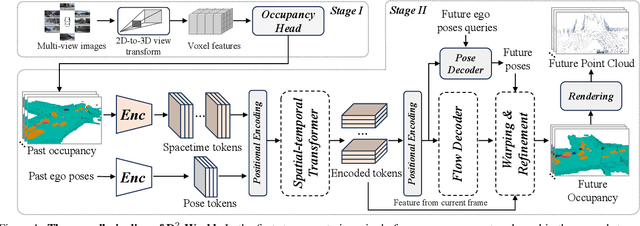

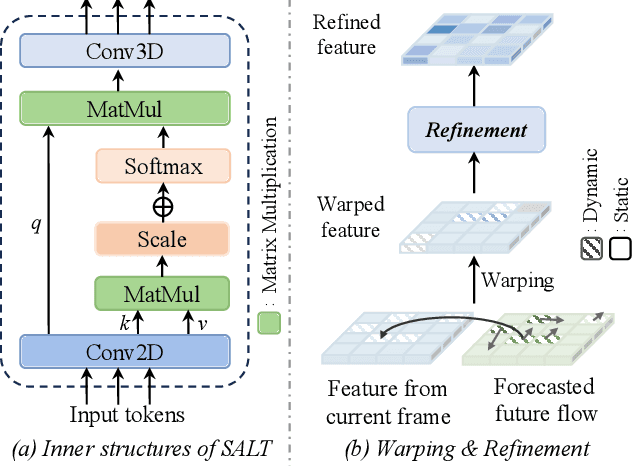
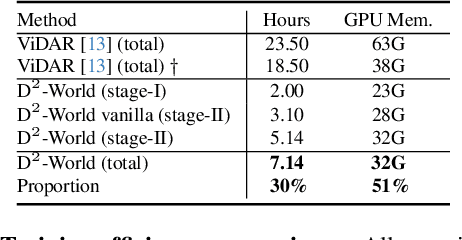
Abstract:This technical report summarizes the second-place solution for the Predictive World Model Challenge held at the CVPR-2024 Workshop on Foundation Models for Autonomous Systems. We introduce D$^2$-World, a novel World model that effectively forecasts future point clouds through Decoupled Dynamic flow. Specifically, the past semantic occupancies are obtained via existing occupancy networks (e.g., BEVDet). Following this, the occupancy results serve as the input for a single-stage world model, generating future occupancy in a non-autoregressive manner. To further simplify the task, dynamic voxel decoupling is performed in the world model. The model generates future dynamic voxels by warping the existing observations through voxel flow, while remaining static voxels can be easily obtained through pose transformation. As a result, our approach achieves state-of-the-art performance on the OpenScene Predictive World Model benchmark, securing second place, and trains more than 300% faster than the baseline model. Code is available at https://github.com/zhanghm1995/D2-World.
VisionPAD: A Vision-Centric Pre-training Paradigm for Autonomous Driving
Nov 22, 2024



Abstract:This paper introduces VisionPAD, a novel self-supervised pre-training paradigm designed for vision-centric algorithms in autonomous driving. In contrast to previous approaches that employ neural rendering with explicit depth supervision, VisionPAD utilizes more efficient 3D Gaussian Splatting to reconstruct multi-view representations using only images as supervision. Specifically, we introduce a self-supervised method for voxel velocity estimation. By warping voxels to adjacent frames and supervising the rendered outputs, the model effectively learns motion cues in the sequential data. Furthermore, we adopt a multi-frame photometric consistency approach to enhance geometric perception. It projects adjacent frames to the current frame based on rendered depths and relative poses, boosting the 3D geometric representation through pure image supervision. Extensive experiments on autonomous driving datasets demonstrate that VisionPAD significantly improves performance in 3D object detection, occupancy prediction and map segmentation, surpassing state-of-the-art pre-training strategies by a considerable margin.
Self-Supervised Graph Neural Networks for Enhanced Feature Extraction in Heterogeneous Information Networks
Oct 23, 2024Abstract:This paper explores the applications and challenges of graph neural networks (GNNs) in processing complex graph data brought about by the rapid development of the Internet. Given the heterogeneity and redundancy problems that graph data often have, traditional GNN methods may be overly dependent on the initial structure and attribute information of the graph, which limits their ability to accurately simulate more complex relationships and patterns in the graph. Therefore, this study proposes a graph neural network model under a self-supervised learning framework, which can flexibly combine different types of additional information of the attribute graph and its nodes, so as to better mine the deep features in the graph data. By introducing a self-supervisory mechanism, it is expected to improve the adaptability of existing models to the diversity and complexity of graph data and improve the overall performance of the model.
OmniBooth: Learning Latent Control for Image Synthesis with Multi-modal Instruction
Oct 07, 2024Abstract:We present OmniBooth, an image generation framework that enables spatial control with instance-level multi-modal customization. For all instances, the multimodal instruction can be described through text prompts or image references. Given a set of user-defined masks and associated text or image guidance, our objective is to generate an image, where multiple objects are positioned at specified coordinates and their attributes are precisely aligned with the corresponding guidance. This approach significantly expands the scope of text-to-image generation, and elevates it to a more versatile and practical dimension in controllability. In this paper, our core contribution lies in the proposed latent control signals, a high-dimensional spatial feature that provides a unified representation to integrate the spatial, textual, and image conditions seamlessly. The text condition extends ControlNet to provide instance-level open-vocabulary generation. The image condition further enables fine-grained control with personalized identity. In practice, our method empowers users with more flexibility in controllable generation, as users can choose multi-modal conditions from text or images as needed. Furthermore, thorough experiments demonstrate our enhanced performance in image synthesis fidelity and alignment across different tasks and datasets. Project page: https://len-li.github.io/omnibooth-web/
Data-Driven Spatiotemporal Feature Representation and Mining in Multidimensional Time Series
Sep 22, 2024
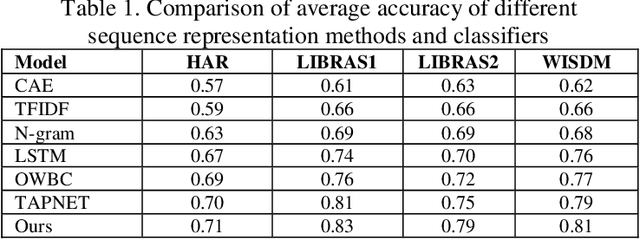
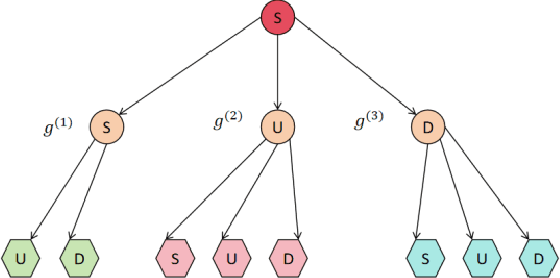

Abstract:This paper explores a new method for time series data analysis, aiming to overcome the limitations of traditional mining techniques when dealing with multidimensional time series data. Time series data are extensively utilized in diverse fields, including backend services for monitoring and optimizing IT infrastructure, medical diagnosis through continuous patient monitoring and health trend analysis, and internet business for tracking user behavior and forecasting sales. However, since the effective information in time series data is often hidden in sequence fragments, the uncertainty of their length, quantity, and morphological variables brings challenges to mining. To this end, this paper proposes a new spatiotemporal feature representation method, which converts multidimensional time series (MTS) into one-dimensional event sequences by transforming spatially varying events, and uses a series of event symbols to represent the spatial structural information of multidimensional coupling in the sequence, which has good interpretability. Then, this paper introduces a variable-length tuple mining method to extract non-redundant key event subsequences in event sequences as spatiotemporal structural features of motion sequences. This method is an unsupervised method that does not rely on large-scale training samples and defines a new model for representing the spatiotemporal structural features of multidimensional time series. The superior performance of the STEM model is verified by pattern classification experiments on a variety of motion sequences. The research results of this paper provide an important theoretical basis and technical support for understanding and predicting human behavior patterns, and have far-reaching practical application value.
Research on Adverse Drug Reaction Prediction Model Combining Knowledge Graph Embedding and Deep Learning
Jul 27, 2024
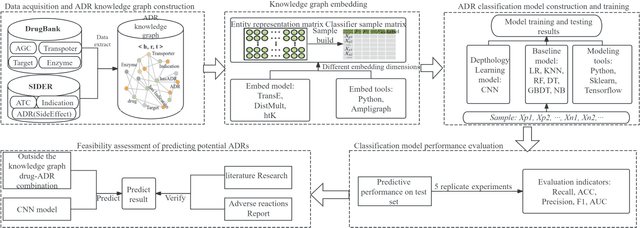
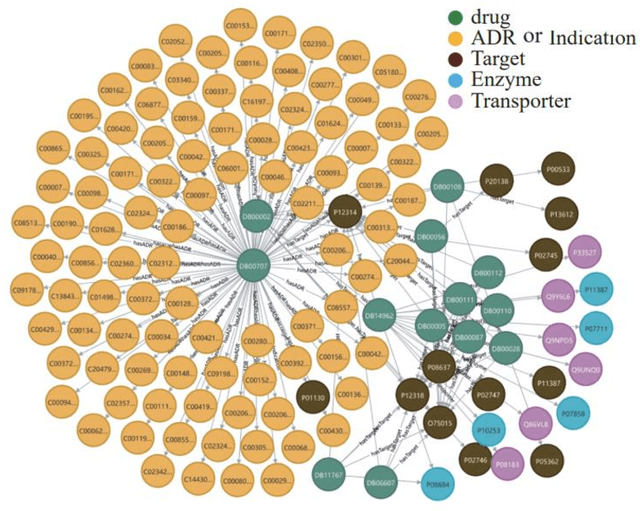

Abstract:In clinical treatment, identifying potential adverse reactions of drugs can help assist doctors in making medication decisions. In response to the problems in previous studies that features are high-dimensional and sparse, independent prediction models need to be constructed for each adverse reaction of drugs, and the prediction accuracy is low, this paper develops an adverse drug reaction prediction model based on knowledge graph embedding and deep learning, which can predict experimental results. Unified prediction of adverse drug reactions covered. Knowledge graph embedding technology can fuse the associated information between drugs and alleviate the shortcomings of high-dimensional sparsity in feature matrices, and the efficient training capabilities of deep learning can improve the prediction accuracy of the model. This article builds an adverse drug reaction knowledge graph based on drug feature data; by analyzing the embedding effect of the knowledge graph under different embedding strategies, the best embedding strategy is selected to obtain sample vectors; and then a convolutional neural network model is constructed to predict adverse reactions. The results show that under the DistMult embedding model and 400-dimensional embedding strategy, the convolutional neural network model has the best prediction effect; the average accuracy, F_1 score, recall rate and area under the curve of repeated experiments are better than the methods reported in the literature. The obtained prediction model has good prediction accuracy and stability, and can provide an effective reference for later safe medication guidance.
Breast Cancer Image Classification Method Based on Deep Transfer Learning
Apr 14, 2024



Abstract:To address the issues of limited samples, time-consuming feature design, and low accuracy in detection and classification of breast cancer pathological images, a breast cancer image classification model algorithm combining deep learning and transfer learning is proposed. This algorithm is based on the DenseNet structure of deep neural networks, and constructs a network model by introducing attention mechanisms, and trains the enhanced dataset using multi-level transfer learning. Experimental results demonstrate that the algorithm achieves an efficiency of over 84.0\% in the test set, with a significantly improved classification accuracy compared to previous models, making it applicable to medical breast cancer detection tasks.
 Add to Chrome
Add to Chrome Add to Firefox
Add to Firefox Add to Edge
Add to Edge